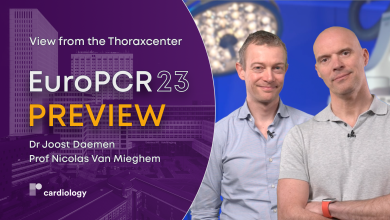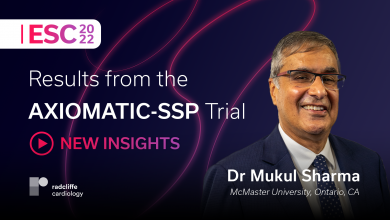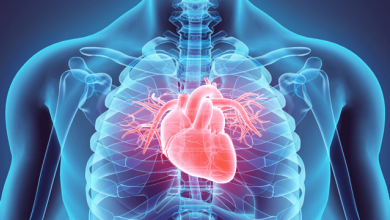Search results
Histopathological Changes and Clinical Implications in Patients with Hypertrophic Cardiomyopathy
Author(s):
Vibeke Marie Almaas
,
Jan Peder Amlie
Added:
3 years ago
Article
Author(s):
Augusto Vicario
,
Gustavo H Cerezo
Added:
3 years ago
Heart-brain interaction is an indisputable fact. The connection between vascular risk factors and/or cardiovascular disease and cognitive impairment and dementia has been supported by countless publications in the past 30 years. The most important studies concluded that vascular brain injury exacerbates cognitive ageing, and increases the risk for dementia both in its vascular type and in its…
View more
Author(s):
Nicolas M Van Mieghem
,
Joost Daemen
Added:
11 months ago
Join Prof Nicolas Van Mieghem and Dr Joost Daemen, interventional experts from the Thoraxcenter at Erasmus MC in Rotterdam, as they provide a comprehensive preview of the late-breaking trials and studies that will be presented at EuroPCR 2023. In this dynamic episode, they offer valuable insights into the latest developments in interventional clinical and research science.
Studies include:…
View more
Author(s):
Marc E Wolf
,
Michael G Hennerici
Added:
3 years ago
Aetiological Classification of Stroke
Precise analysis of stroke subtypes is important for clinical treatment decisions and prognostic evaluation of patients leading to adapted individual patient management. The most widely used system of aetiological ischaemic stroke classification is the Trial of Org 10172 in Acute Stroke Treatment (TOAST) classification, proposed in 1993 for an acute stroke…
View more
Author(s):
Anouar Belkacemi
,
Pierfrancesco Agostoni
,
Michiel Voskuil
,
et al
Added:
3 years ago
In the past few decades, major progress has been made in the percutaneous treatment of coronary artery disease. Initially, the emergence of balloon angioplasty offered an alternative option for coronary revascularisation. However, abrupt closure and restenosis caused by elastic recoil, neointimal hyperplasia and late remodelling were major drawbacks of balloon angioplasty.1 The use of drug…
View more
Author(s):
Mukul Sharma
Added:
1 year ago
ESC Congress 22 — We are joined onsite by Dr Mukul Sharma (Mcmaster University, CA) to discuss the findings of the AXIOMATIC-SSP (NCT03766581) trial.
This study aimed to evaluate the effectiveness of oral Factor XIa inhibitor milvexian in addition to aspirin and clopidogrel as compared to standard therapies in secondary stroke prevention. 2366 participants were involved in the trial, and were…
View more
Author(s):
Bruno Scheller
,
Bodo Cremers
,
Stephanie Schmitmeier
,
et al
Added:
3 years ago
Coronary angioplasty was introduced to clinical practice by Andreas Grüntzig in 1977.1 In the coronary field, the most important improvement in angioplasty has been achieved with the introduction of stents. A significant proportion of the complex modern coronary interventional techniques rely on stenting. Stenting overcomes recoil and dissections but not restenosis due to neointimal proliferation…
View more
Author(s):
Myriam Edjlali-Goujon
,
Daniel Alison
Added:
3 years ago
Digital ischaemia is an uncommon pathology, with an incidence of two cases per 100,000 people per year.1 Diagnosis is mainly based on clinical symptoms: the patient presents a painful digital extremity with signs of ischaemia (blue finger) or even necrosis. Clinical context and medical history are also important to determine the aetiology of digital ischaemia.
The role of imaging modalities is…
View more
Author(s):
Mai Tone Lønnebakken
,
Eva Gerdts
Added:
3 years ago
Coronary artery disease (CAD) remains a diagnostic challenge, even though there are several diagnostic techniques available for the detection of ischaemia – assessed either as function or perfusion abnormalities or directly by demonstrating anatomical coronary stenoses.1 An overview of different non-invasive modalities used in the diagnosis of myocardial ischaemia and their average sensitivity…
View more
Author(s):
Andrea Aparicio
,
Javier Cuevas
,
César Morís
,
et al
Added:
2 years ago













